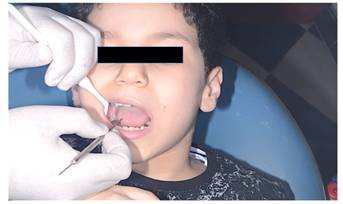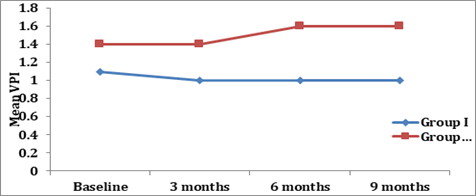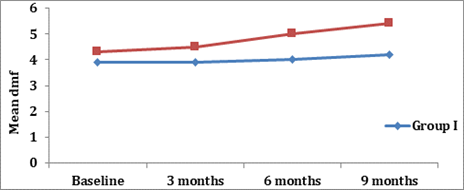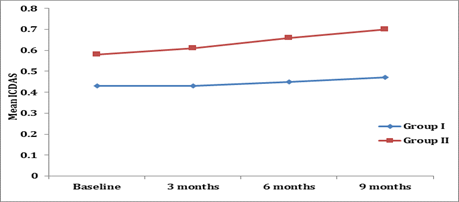Research
The Effectiveness of Educational Mobile Messages on Prevention of Dental Caries in Group of Preschool Children
1Dentist at Egyptian Ministry of Health.
2Head of Pedodontics and Oral Dental Health, Faculty of Dental Medicine for Girls, Al-Azhar University.
3Lecturer of Pedodontics and Oral Dental Health, Faculty of Dental Medicine for Girls, Al-Azhar University.
*Corresponding Author: Walaa F. Elsakkar,Dentist at Egyptian Ministry of Health.
Citation: Walaa F. E, Mohammed H. M, Sara N. H. (2023). The Effectiveness of Educational Mobile Messages on Prevention of Dental Caries in Group of Preschool Children. Dentistry and Oral Health Care, BioRes Scientia Publishers, 2(3):1-6. DOI: 10.59657/2993-0863.brs.23.012
Copyright: © 2023 Walaa F. Elsakkar, this is an open-access article distributed under the terms of the Creative Commons Attribution License, which permits unrestricted use, distribution, and reproduction in any medium, provided the original author and source are credited.
Received: August 15, 2023 | Accepted: August 25, 2023 | Published: September 19, 2023
Abstract
Purpose: To estimate the impact of providing mobile educational messages on prevention of dental caries in group of preschool children.
Materials and methods: 100 high caries risk children aged between 3 and 5 years from both genders were randomly allocated into two groups (n=50) regarding to receiving educational messages: test group; included children whose parents received educational messages and control group; included children whose parents didn’t receive any messages. Every 14 days the test group received educational messages via Whats Application Messenger (WhatsApp). Visible plaque index (VPI), the decayed, missed, filled (dmf) and the International Caries Detection and Assessment System (ICDAS) indices were measured at the start of the study, 3-, 6- and 9-month follow-ups, whereas Health Literacy levels and dietary habits were determined by HEALS literacy questionnaire at the start of the study and 9-month follow-up.
Results: Educational messages increased parental HEALS scores, enhancing children’s oral health and reducing the severity of dental caries.
Conclusion: Mobile educational messages provided through WhatsApp were efficient in reducing dental caries among preschool children and enhancing health literacy of the parents.
Keywords: whatsapp: icdas; educational messages; health education
Introduction
One of the most popular chronic human illnesses is dental caries. Recently, newer strategies were used for prevention of dental caries and conservation of tooth structure instead of disease management by restorative treatment. Strategies used to prevent caries include tooth brushing, dental flossing, fluoride application, pit-and-fissure sealants, the use of sugar substitutes, the development of a dental caries vaccine, and the role of primary caregiver or parents for children [1]. Unfortunately, many children even those as young as one year affected with dental caries. Dental caries causes difficulties in chewing and phonation, pain and esthetic problems, affecting a child’s self-confidence, weight and growth. Also, about 94 percent of children diagnosed with caries develop caries in the permanent dentition [2]. Oral health education is one of the measures recommended by the Ministry of Health to promote oral hygiene, especially from early childhood in the preschool stage, which corresponds to the establishment of habits [3]. The parents or primary caregiver plays vital role in regulating the interaction between the child and its surroundings through the dietary habits, oral hygiene and other preventive behaviors and services provided to the child. Therefore, it is important to provide proper dental health information to parents. Smartphones and tablets provide variety of health-related applications. In this sense, electronic mobile based health interventions could benefit a huge number of individuals by making information available even with the absence of physical and human resources. Therefore, the use of electronic applications for oral health education can be very helpful [2]. Several researches have shown that tele dentistry using instant messages for the diagnosis and treatment planning of dental caries in children with mixed dentition is reliable and efficient [4]. The use of mobile phone cameras for caries screening was tested [5]. Also,improvement in dental health [6]. Videoconference as a treatment planning modality for patients in need of prosthetic rehabilitation and real-time telemedicine to exchange expert opinions in the field of pre-implant dental assessment were evaluated [7]. With over 300 million users globally, Whats Application Messenger (WhatsApp) is one of the most popular smartphone applications [2]. It simply requires a wireless fidelity (Wi-Fi) internet network so that people can link through free electronic messages [8,9]. WhatsApp has been proved to be a viable tool for patients-professionals contact as well as for dissemination of health-related information [10]. With this in mind, the goal of the present research was to see how efficient mobile educational messages sent through WhatsApp are at preventing dental caries in preschool children of a given population.
Materials And Methods
This was a single-blinded, parallel, and observational study with 9- months follow up period. It was carried out on 100 high caries risk children aged between 3 and 5 years of both genders attending outpatient’s dental clinic of Pediatric Dentistry at Faculty of Dentistry, Girl's branch, Al-Azhar University. The Research Ethics Committee, Faculty of Dental Medicine for Girls, Al-Azhar University authorized the current research (code: REC-PE-21-14). Before each child’s participation in the research, his or her parents signed a written informed consent form. The following selection criteria were used to recruit parents and children [2]. High caries risk children who are aged 3 to 5 years, as defined by the Caries Risk Assessment Form for 0- to 6-year-old criteria [11]. This includes children who consume bottle with anything other than water before going to bed and had caries lesions or restoration in last 24 months. Regarding the International Caries Detection and Assessment System (ICDAS) guidelines, [1,2]. Children with a score of 3 or less (no cavities). Also, parents or caregivers with smartphone with internet connection, who signed a written informed consent form and who already have WhatsApp on their devices, or who agreed to install it were eligible to participate in the research.
Sample size calculation
Calculation was estimated using CDC Epi Info program version 7.2.0.1 (Atlanta, USA) assuming a power of 80%, alpha=0.05 and attrition of 30% to detect significant difference in the effectiveness of messages sent via smartphones on prevention of dental caries in group of preschool children compared to control group receiving no educational messages. A total sample of 80 parents and children (40 each group) is needed based on the criteria and outcomes described by previous study [1,3]. The sample was increased to 100 (50 each group) due to the expectation of missed data.
Subjects grouping
Parents and children were randomized into two equal groups (n=50) based on parameters of stratification, as follows: the ICDAS index, caries risk assessment and age of children: group I (test group): received educational messages via WhatsApp and group II (control group): didn’t receive educational messages.
Interventions
Every 14 days, mobile educational messages about dental caries prevention were delivered to the test group’s parents or caregivers by WhatsApp. These text messages which included dietary recommendations and recommendation on how to brush your teeth, were written with in plain Arabic to make them easier to understand. In order to confirm the compliance and involvement in the research, parents of the test group were asked to turn on the read verification feature. All parents and children were called for follow up at 3-, 6- and 9- months. An experienced dentist evaluated the kids to determine the primary results and provided dental prophylaxis afterward. On the decalcified surfaces (ICDAS=1 or 2) fluoride varnish was used, if necessary, while localized enamel lesions (ICDAS=3) were sealed with glass ionomer cement.
Measurements and outcomes
Oral and dental examination for all children was performed by a trained dentist at the beginning, 3-, 6- and 9-months follow up visits (Fig.1). The visible plaque index (VPI) was first calculated by examining the buccal surfaces of six primary teeth (#55, #53, #51, #71, #73 and #75) (14). Subsequently, all teeth surfaces were cleaned then dried to evaluate dental caries using the decayed, missed, filled index (dmf) and the international caries detection and assessment system index (ICDAS).
Figure 1: Oral examination
Additionally, Health Literacy Scale was used to measure the health literacy levels of parents or caregivers [2]. The Health Literacy Scale (HEALS) was translated into Arabic language and applied on google forms in the form of sheet containing 9 questions regarding the abilities required for the proper health information consumption. These data were gathered at the start of the study and at the end of nine- month follow up period. Also, parents or caregivers were asked a series of questions that included socioeconomic and health-related information on their children such as date of birth, sex, and educational status.
Statistical method
The Statistical Package for Social Sciences (SPSS) version 24 was used for data management and statistical analysis. Fisher’s exact test was used to examine differences in categorical variables. Means and standard deviations as well as medians and ranges were used to summarize numerical data. The Kolmogrov-Smirnov and Shapiro-Wilk tests were used to look for normality in the data. Numbers and percentages were used to summarize categorical data. The independent t test was used to compare the two groups on normally distributed numeric variables, and the Mann Whitney test was used to confirm robustness. Overtime comparisons were made using repeated measure ANOVA and the Bonferroni post hoc test. A paired t test was used to compare scores before and after. P-values are always two-sided. P-values of less than 0.05 were deemed statistically significant.
Results
Clinical parameters
Visible Plaque index
For Group I: the mean VPI was 1.1±0.5 at the baseline that changed to 1.0 ±0.5, 1.0 ±0.5 and 1.0 ±0.5 after 3, 6 and 9 months respectively; this was statistically significant with p value <0>
Figure 2:Line chart representing mean of VPI of the studied groups’ overtime.
Dmf index
For Group I: the mean dmf was 3.9 ±1.0 at the baseline that changed to 3.9 ±0.9, 4.0 ±0.9 and 4.2 ±1.1 after 3, 6 and 9 months respectively; this was statistically significant with p value <0>
ICDAS
For Group I: the mean ICDAS was 0.42±0.17 at the baseline that changed to 0.43±0.17, 0.45 ±0.17 and 0.47 ±0.16 after 3, 6 and 9 months respectively; this was statistically significant with p value =0.015. For Group II: the mean ICDAS was 0.58±0.16 at the baseline that changed to 0.61 ±0.17, 0.66 ±0.18 and 0.70 ±0.20 after 3, 6 and 9 months respectively; this was statistically significant with p value <0>
Figure 4: Line chart representing mean of ICDAS of the studied groups’ overtime.
Survey data
Comparison between groups was comparable regarding all the questions and total scores before intervention. P≤ 0.05 is statistically significant. After intervention, the test group improved in all measures, with 92.0 percent caring about health compared to 74.3 percent of the control group, which was statistically significant (p value = 0.026). The mean knowledge score was 6.7±1.3 at baseline that changed to 8.0±1.6 representing 19% increase from the baseline, this was statistically significant p<0>
Discussion
Caries is an infection disease that destroys the enamel of the tooth. Dental caries has a negative impact on the health and well-being of children. Despite preventive measures, tooth decay is a worldwide problem. As soon as the child’s first tooth emerges, he or she is subjected to caries. Most children under the age of five spend the majority of their time with their parents. The knowledge and practices of parents have an effect on their children’s dental health [15]. Epidemiological studies are important for oral health education, monitoring trends in dental caries and for assessing the dental needs. Therefore, the goal of the present epidemiologic research was to see how efficient mobile educational messaging is at preventing dental caries among preschool children. This study found that mobile phone applications, including texting via WhatsApp Messenger in particular, have been found to be effective for increasing levels of health education of parents. Another research found that, using WhatsApp Messenger as a tool to prevent oral diseases resulted in considerable reduction of teen’s dental plaque [16]. In the current study, we selected children aged between 3 and 5 years because it is thought that excellent dental habits planted in children early in life will stick with them throughout their lives. Because variation in parental employment and income lead to differences in children’s dental health, all of the study participants were chosen from similar socioeconomic backgrounds. In the present study ICDAS system was used for caries detection as it is suitable for detection of any carious changes in tooth occlusal surfaces, proximal surfaces, smooth surfaces, root surfaces, restorations and sealants. The findings of this study result in better oral health status of preschool children of the test group. This was indicated by high percentage of children in the test group who had no changes in their maximal ICDAS. This was in agreement with other study [17] which found that, educational messages had a positive influence on the vulnerable groups’ involvement and attitudes toward ECC. Also, the average dmf of the control group was increased with time, while the average dmf of the test group remain stable. The mean VPI in the test group was decreased over the follow up period, while in the control group the mean VIP was increased. This was in disagreement with other study [14]. which stated that VIP was stable in the two groups over 6 months with minimal tendency of decrease. This can be explained by the practical difficulties of parents in following professional recommendations about oral hygiene, mainly because children’s negative behaviors. Another study agreed with the present study which found that, the visible plaque index for the experimental group decreased considerably between the start of the study and the T1 follow up [18]. The mean knowledge of the participants of this study was increased. Before intervention, the comparison between groups was comparable regarding all the questions and total scores while after intervention the test group showed improvement in almost all of parameters; caring about health were 92.0% compared to 74.3% in control group and this agreed with other study [14]. Therefore, it can be suggested that sending educational messages via WhatsApp to the parents of preschool children was effective in decreasing caries incidence among preschool children and increasing the parent's awareness toward oral health.
Conclusion
Based on the finding of the current study it could imply that the use of mobile technologies especially texting via WhatsApp in oral health education is effective for increasing oral health awareness and prevention of dental caries.
Declarations
Acknowledgments
To all of caregivers and kids who took part in the research without whom this study would not have been performed.
Recommendations
Using other mobile phone and social media applications for health education.
Interests Of Conflict
There are no conflicts of interest.
Funding
No funding was received for this study.
References
- Lee Y. (2013). Diagnosis and Prevention Strategies for Dental Caries. J Lifestyle Med, 3:107-109.
Publisher | Google Scholor - Aguirre P, Lotto M, Strieder A, Cruvinel A, Cruvinel T. (2019). The Effectiveness of Educational Mobile Messages for Assisting in the Prevention of Early Childhood Caries: Protocol for a Randomized Controlled Trial. JMIR Res Protoc, 8:13656.
Publisher | Google Scholor - Campos LF, Cavalcante JP, Machado DP, Marçal E, Silva PG, Rolim JP, et al. (2019). Development and evaluation of a mobile oral health application for preschoolers. Telemed J E Health, 25:492-498.
Publisher | Google Scholor - Alshaya MS, Assery MK, Pani SC. (2020). Reliability of mobile phone teledentistry in dental diagnosis and treatment planning in mixed dentition. J Telemed Telecare, 26:45-52.
Publisher | Google Scholor - Estai M, Kanagasingam Y, Xiao D. (2017). End-user acceptance of a cloud-based teledentistry system and Android phone app for remote screening for oral diseases. J Telemed Telecare, 23:44-52.
Publisher | Google Scholor - Patil S, Hedad IA, Jafer AA. (2020). Effectiveness of mobile phone applications in improving oral hygiene care and outcomes in orthodontic patients. J Oral Biol Craniofacial Res, 11:26-32.
Publisher | Google Scholor - Madi M, Kumar M, Pentapati KC, Vineetha R. (2021). Smart-phone based telemedicine: Instant messaging application as a platform for raSdiographic interpretations of jaw pathologies. J Oral Biol Craniofac Res. 11:368-372.
Publisher | Google Scholor - Astarcioglu MA, Sen T, Kilit C, Durmus HI, Gozubuyuk G, Kalcik M, et al. (2015). Time-to-reperfusion in STEMI undergoing interhospital transfer using smartphone and WhatsApp messenger. Am J Emerg Med, 33:1382-1384.
Publisher | Google Scholor - Montag C, Błaszkiewicz K, Sariyska R, Lachmann B, Andone I, Trendafilov B, et al. (2015). Smartphone usage in the 21st century: who is active on WhatsApp? BMC Res Notes, 8:331.
Publisher | Google Scholor - Giordano V, Koch H, Godoy-Santos A, Belangero WD, Pires RE, Labronici P. (2017). WhatsApp messenger as an adjunctive tool for telemedicine: an overview. Interact J Med, 6:11.
Publisher | Google Scholor - American Academy of Pediatric Dentistry. (2013). Guideline on caries-risk assessment and management for infants, children, and adolescents. Pediatr Dent, 35:157-164.
Publisher | Google Scholor - Cabral GMP, Castro AMGS, Ferreira ACFM, Bonacina CF, Lussi A, Santos MTBR, et al. (2021). Caries prevalence using ICDAS visual criteria and risk assessment in children and adolescents with cerebral palsy: A comparative study. Spec Care Dentist, 41:688-699.
Publisher | Google Scholor - Zotti F, Dalessandri D, Salgarello S, Piancino M, Bonetti S, Visconti L, et al. (2016). Usefulness of an app in improving oral hygiene compliance in adolescent orthodontic patients. Angle Orthod. 86:101-107.
Publisher | Google Scholor - M, Strieder AP, Ayala Aguirre PE, Oliveira TM, Rios D, Cruvinel T, et al. (2020). Parental-oriented educational mobile messages to aid in the control of early childhood caries Lotto in low socioeconomic children: A randomized controlled trial. J Dent, 101:103-106.
Publisher | Google Scholor - Sabbagh HJ, Alghamdi DS, Almutairi WM, Alshahrani SA, Alghamdi AS. (2016). Knowledge and practices for early childhood caries prevention among parents of the children visiting king abdulaziz university pediatric dental clinics, Kingdom of Saudi Arabia. Journal of Contemporary Dentistry, 9:53-58.
Publisher | Google Scholor - Badawy SM, Kuhns LM. (2017). Texting and mobile phone app interventions for improving adherence to preventive behavior in adolescents: a systematic review. JMIR Mhealth Uhealth, 5:50-55.
Publisher | Google Scholor - Borrelli B, Henshaw M, Endrighi R, Adams WG, Heeren T, Rosen RK, et al. (2019). An Interactive Parent-Targeted Text Messaging Intervention to Improve Oral Health in Children Attending Urban Pediatric Clinics: Feasibility Randomized Controlled Trial. JMIR Mhealth Uhealth, 7:142-147.
Publisher | Google Scholor - Almabadi ES, Bauman A, Akhter R, Gugusheff J, Van Buskirk J, Sankey M, et al. (2021). The Effect of a Personalized Oral Health Education Program on Periodontal Health in an At-Risk Population: A Randomized Controlled Trial. Int. J. Environ. Res. Public Health, 18:846-852.
Publisher | Google Scholor















